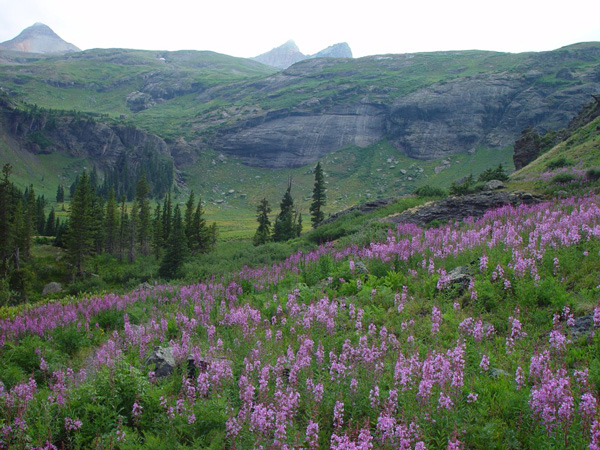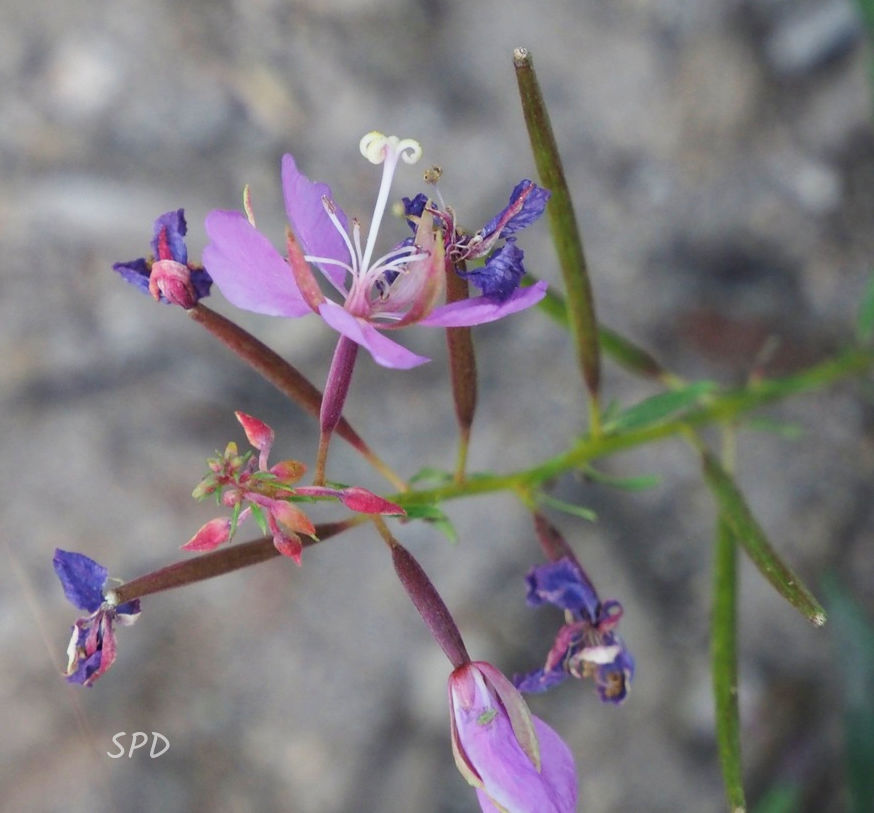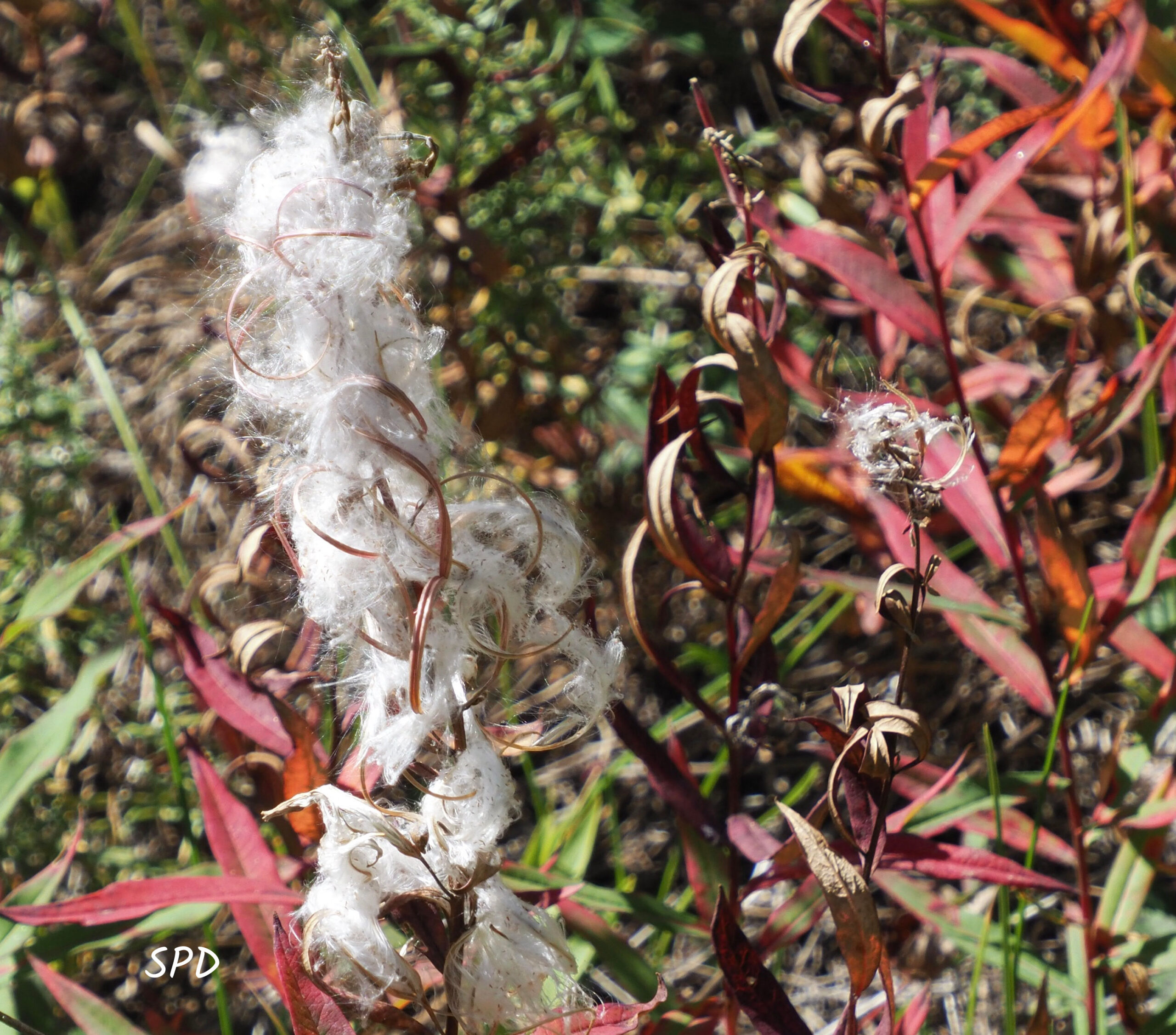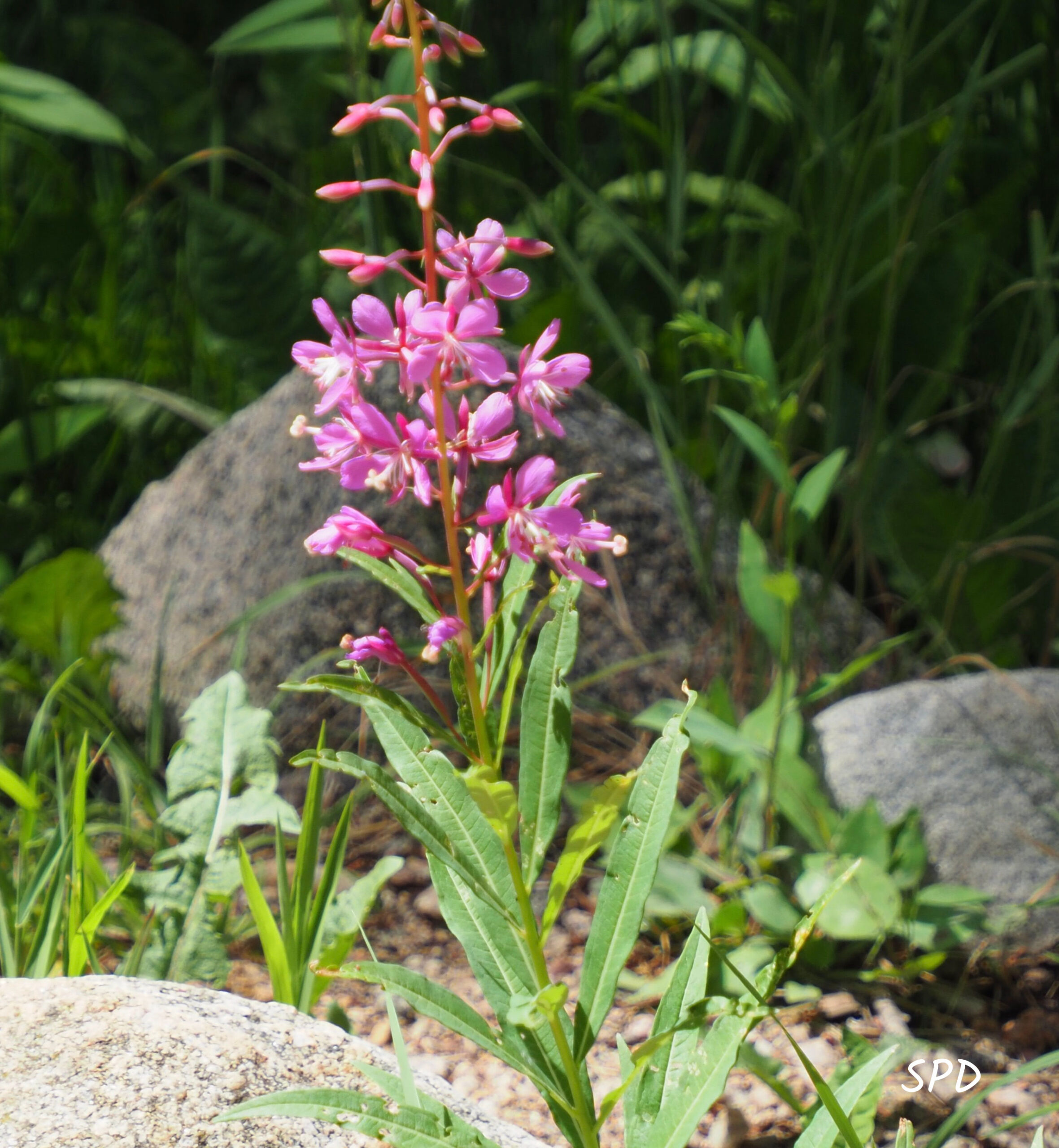On a summer hike in a burn area, people point to pink-purple understory patches and ask, “What’s that?” After a fire, this native perennial re-carpets our land in striking stands. Fireweed, Chamerion angustifolium, was one of the top-producing plants re-colonizing Mount St. Helens volcano a year after its massive eruption and fire in 1980. In World War II Great Britain it earned the moniker “bombweed” because it blossomed in magenta opulence from the grey dreary ashes of London after the fire bombings. (The buildings having been mostly wood, the postwar conditions were akin to a burned forest). It’s also known as “St. Anthony’s laurel,” said to be one of the plants St. Anthony used for healing.
Established fireweed plants can colonies through spreading rhizomes on a hillside like this one near Silverton. Photo courtesy of Skot Latona
It’s very genetically diverse, and has savvy reproductive strategies. It graces, and confounds home landscapes with these wild ways. All good reasons to take note of this plant, which will continue to companion us into the foreseeable future. Here we’ll look more closely at fireweed’s (1) botany (2) ecology (3) ecosystem restoration potential on the land and in the home native plant-pollinator garden and landscape (4) other human uses – food, fiber, medicine. (5) We’ll also note invasive plants with which fireweed can been confused on first glance – purple loosestrife, dame’s rocket, and hairy willowherb.
Fireweed’s many names
Fireweed is in the Onagraceae, evening primrose family. Three different genus names are associated with fireweed, Epilobium, Chamaermerion, and Chamerion. It’s found in the literature under all three of those. In the 1700s Linnaeus used Epilobium for fireweed, combing epi (upon, above) with lobium, (a pod) which describes the placement of its flower on top of its seed pod. Shortly thereafter, other scientists disagreed and proposed calling it the Greek-derived name, Chamaenerion for “dwarf (chamai) oleander (nerion).” It took two hundred years for that name to be formally adopted. Some scientists then shortened it to Chamerion for ease of use. Ackerfield’s Flora of Colorado uses Chamerion.
In Colorado, we have two species of Chamerion, C. angustifolium, which means narrow-leaved, and C. latifolium, which means broad-leaved. Angustifolium is the species most common here and fireweed is the name associated with it in our Flora. The less common C. latifolium is called dwarf fireweed in the Flora, but goes by several other common names including alpine fireweed and river beauty; it likes getting its feet wet. C. angustifolium will grow along the water’s edge but not in standing water.
Alaback writes: “dwarf fireweed or river beauty is short or even creeping but with even larger pink-red flowers with petals nearly an inch long [they can be up to twice as long as common fireweed] and wider leaves. Both of these species can make colorful displays that are hard to miss in the mountains.” For a more detailed take on fireweed’s botanical names and genes, please see Kathy Keeler’s A Wandering Botanist.
Another of fireweed’s common names from Great Britain is “rose-bay willow herb” because some say its petals resemble those of roses and its leaves those of bay and, of course, willow. It’s also known as “great willow herb” because it can grow up to nine feet tall under the right moist, sunny conditions (mostly not in Colorado).
Botany
How can you identify it?
Key identifying characteristics are the four bright pink/purple petals (less commonly red or white), with a narrow sepal, of the same color but a darker hue, behind and between the petals. Per Flora of Colorado, each petal is about half an inch long. The style and stigmas in fireweed prominently stick out; the style is about half inch longer than the stamens. Other key features are its tall, narrow stems with mostly opposite, smooth leaves that are five to ten times as wide as long long, narrow seed pod capsules, and its cottony, wind-dispersed seeds. Fireweed researcher, Dr. Paul Alaback, writes, “they readily hybridize so can sometimes be hard to identify.”
An exserted style is charteristic of fireweed.
Alaback notes: “ I think it is quite spectacular in the fall with its bright scarlet leaves and the seeds blowing around and capsules splitting, iconic for hiking in the late summer or fall. Fruits blowing in wind and leaves turning are good signs of the fall season approaching.” There is an old saying: “when fireweed turns to cotton, summer will soon be forgotten.”
What are the seeds like?
Each flower is perched at the end of its fruit, a long, narrow capsule containing 300-500 seeds. The seeds are very tiny, approximately 6,800,000 per pound. Just one fireweed plant alone can produce 80,000 seeds per year! The wind catches the tuft of long silky hairs at one end of the seed and bears it high aloft, sometimes up to 200 miles away. What brings them down to earth? They sense humidity, which causes the plume to contract and descend.
Almost one hundred percent of newly collected fireweed seeds are said to germinate within 10 days in warm, moist conditions in a variety of temperatures 40 degrees Fahrenheit or over.
Ecology
Where is fireweed native?
Most of the U.S., all of Canada, in fact, in higher altitude temperate and boreal zones all over the world. See this map.
In what habitat does it grow?
Fireweed grows in a wide range of open and disturbed habitats, from sea level to the high alpine, 5300 to 12,500 ft. in Colorado. It loves moist, rocky, disturbed areas: burned, logged, patch-cut, clearcut or windthrown forests, edges of forests, roadsides, avalanche areas, recently de-glaciated areas, highway and railroad rights-of-way, waste places, and old fields. It likes moist areas along streams, lakes and bogs, while its cousin, river beauty, likes to grow in river bars and recently flooded floodplains.
Does fireweed prefer sunlight or shade?
Fireweed will persist as a stand in a burned forest as long as the canopy remains open and there’s plenty of sunlight; it will hang on, less and less productively, as the canopy closes and sunlight dims.
Fireweed, Chamerion angustifolium. Key characteristics for ID include tall, narrow stems with mostly opposite, smooth leaves that are five to ten times as wide as they are long.
In what kind of climate and rainfall does it do best?
It likes short, warm summers and long, cold winters. It makes do with a huge range of annual precipitation across its global growing area: between 13 inches and 134.7 inches. In wet areas it can grow up to nine feet high. This robust native perennial wildflower tolerates dry (but not arid) to wet (but not very wet) soil. It leaves waterlogged soils to river beauty.
In what kind of soil does fireweed flourish?
Quite a range! It grows in a thin soil above permafrost in the subarctic regions of the world to deep loams in the western U.S. as well as in clays and even unweathered parent material; organic matter may be low or very high and peaty. Severe fires burn up organic soil layers, leaving mineral soil exposed. This is the kind of seedbed fireweed seeds are said to favor. Research has shown that fireweed grown in soil with pH 3.5, it was found to produce 80 percent fewer seeds than when grown in a 5 pH soil. And it does grow in neutral soils. In less than ideal conditions it is less fertile, but it can grow.
What is fireweed’s importance to wildlife?
Rocky Mountain elk depend on fireweed in summer, sometimes favoring it over other plants. It is one of many choices for white-tailed and mule deer. Moose in Alaska have been seen to eat fireweed before it flowers, but not after. Why? Tannins are produced in the flowers; tannins precipitate proteins, lowering how much protein an herbivore actually gets from a given mouthful. That may be why they prefer their fireweed as buds only. Small mammals like pikas and chipmunks also eat the fireweed’s seeds.
Are there any pests or potential problems associated with fireweed?
Fireweed is the alternate host of the rust Pucciniastrum Abieti-chamenerii (Pucciniastrum epilobii) that causes needle rust in Abies balsamea, Balsam fir, which is a favorite Christmas tree, and although not native to CO, we do have tree farms here. Fireweed may act as a reservoir for root-rotting Honey fungi, Armillaria spp., which parasitizes lodgepole pine. The rust fungus Puccinia gigantean parasitizes C. angustifolium, reducing flowering and causing early death of the shoot or plant.
Ecosystem Restoration in the wild and at home
How does fireweed reclaim burned land after a wildfire?
Fireweed kicks off post-fire land restoration in two ways: via widely spreading, fast-growing rhizomes and via seeds. The rhizomes have been waiting patiently, even for decades, in the soil of a mature forest for the next fire. (You may not even know fireweed is there if the forest canopy is closed.) Most of the rhizomes are within two inches of the soil surface (some say six inches), though they have been found over a foot deep. It is said the rhizomes are able to survive at least a medium-intensity fire depending on how close to the surface they are and how intense the fire. Certainly we have seen it after high-intensity conflagrations such as the Mt. Helens volcano eruption, the 1988 Yellowstone fires and wildfires local to us. Rhizomes can begin growing at 40 degrees Fahrenheit. The new shoots can bloom within 20 to 30 days after a canopy-clearing fire. The more the rhizomes are fragmented, the more shoots pop up, covering the burn in dense stands.
The second restoration strategy is via its seeds, which explode in profusion from these new shoots. They may be blown to an area with or without fireweed rhizomes. Information on collecting the seeds is below.
How is fireweed used in restoring disturbed sites?
Some land managers say fireweed is the most useful forb for restoration in the montane. It stabilizes soils and grows effectively on reclaimed soils. It is seeded to revegetate mined lands. Sometimes it doesn’t wait to be asked: “Fireweed voluntarily seeded into plantings of commercial species on coal strip mines in Alaska.” “Fireweed formed mycorrhizal associations on coal mine spoils.” (USFS Fire Effects Information System)
It excels at nutrient capture, accumulation, and cycling on newly reclaimed sites. “Its tiny seedlings and rhizomes reach deep, even crack through rocks to pull minerals up from deep within the earth” (University of Colorado at Boulder Museum of Natural History). It takes up and recycles significantly more nutrients such as potassium, magnesium, manganese, phosphates, and zinc from burned areas than unburned ones.
What about fireweed for native plant-pollinator gardens?
Fireweed attracts a lot of pollinators with its generous nectar and pollen, a broad variety of native bees, flies, butterflies, other insects and hummingbirds. Native and non-native bees are said to be fireweed’s most common pollinators. In Canada and Alaska fireweed is an important honeybee plant.
If it’s a hard year on pollinators fireweed can still flower because it can self-fertilize as a backup strategy. The anthers swing into action days before the style is ready to receive the pollen, in fact the style not only remains closed, it leans away from the anthers and the anthers from the style, leaving the pollen to the pollinators. The style only opens and leans toward the anthers when most of the pollen has gone to other flowers, thus promoting cross-pollination and maximizing genetic vibrancy, with that lean-in backup plan as insurance policy.
In terms of fire mitigation, is it ok to plant fireweed close to the house?
Fireweed has a low flammability rating, so yes, it can be used within 5-30 ft. of the home. It has a high moisture content and a high ash content as well.
Can you collect seeds on your land?
Yes. The plant flowers from bottom to top over a period of a few months, so lower flowers may have gone to seed while those higher up are still just budding out. Keep an eye out for flowers starting in June or July; seeds mature about a month later, the colder the climate the later the emergence, and usually flower through September. Most seeds are released in August, release continues after the aerial parts of the plant have died back from frost. Some say fireweed seeds can last longer if preserved in your home in sealed containers kept at 34-37F than they do in some soils’ seed banks.
In late summer and fall, the aerial parts turn red before dying. Leave its dead stems standing for overwintering pollinating and other insects. Think “naturalistic” for landscaping. Fireweed seeds that have fallen to the soil surface germinate. Often the primary and secondary roots of these seedlings develop buds late in the growing season and overwinter just below the soil surface, ready to shoot up when the soil reaches 40 degrees Fahrenheit the next spring.
You can take cuttings from these roots in the late fall or early spring for transplanting. If fireweed starts to take over your sunny garden, cut it back before seed set. Also consider planting it initially near young trees or bushes which will eventually shade out the area to some extent, or prune for the desired amount of closed canopy with respect to the fireweed.
Human Uses: food, fiber, medicine
How have humans throughout history used the gifts of fireweed and how is it used today?
Fireweed has been important everywhere it has planted itself. Choice patches of fireweed were even owned by high-ranking families in British Columbia. (USFS Plant of the Week: Fireweed)
Fireweed’s honeybee pollinators turn its abundant nectar into honey, popular in Alaska and a big player in the Canadian honey market. In the former Soviet Union, beekeepers have kept their hives on the move from one freshly logged area to the next, ensuring prodigious fireweed nectar for their bees. Pounds of honey obtained were reported to be as high as 892.2 per acre (1,000 kg/ha).
Fireweed shoots are one of the first spring vegetables, said to be high in vitamins A and C. Fireweed petals are made into jelly and whole flowers into syrup. Some writers recommend adding flowers and leaves to salads or munching while hiking, although one author in Utah found a local subspecies unbearably spicy-hot. Some people eat the raw stem pith of the fireweed before blooming. Others prefer their stem piths boiled or steamed like asparagus. Some traditional cultures have thickened and flavored soups with the stem pith. And fermented it into ale and vinegar.
In Russia, mature fireweed leaves have been dried and fermented into the famous Ivan Chai, “John’s Tea,” recipes can be found for sale these days online. Watch James Beard Award-winning chef Hank Shaw as he demonstrates how to prepare Fireweed Tea.
As with all wild plants, be 100% sure you have identified and harvested the plant correctly; all responsibility with wild-crafting and ingesting is yours.
After the inner pith was eaten, some made cordage from the stem’s outer fibers. Coastal peoples have used this for fishing nets and for weaving other items. Others have mixed the fluffy seeds with hair from mountain goats or dogs or duck feathers for weaving into blankets, rugs, mats.
Many more traditional functions and medicinal uses are attributed to fireweed. (Moerman’s Native American Ethnobotany).
Invasive Plants Fireweed can be Confused with on First Glance
These are: purple loosestrife, dame’s rocket, and hairy willowherb. For excellent descriptions of these three, see the Colorado Department of Agriculture noxious weeds section for Purple loosestrife, Dame’s rocket, and Hairy willowherb. Even a glance at these photos will reveal how different they really are from fireweed.
Summary
Thanks to its penchant for fire-following, fireweed is likely to become even more familiar in coming years. With its wide genetics, it’s a rich study in adaptability, environmental repair, and human usage, a plant to watch as our weather and climate change.
Pam Sherman
Long time CoNPS member
Special thanks to Dr. Paul Alaback
Professor Emeritus of Ecology,
University of Montana
CoNPS Boulder Chapter





